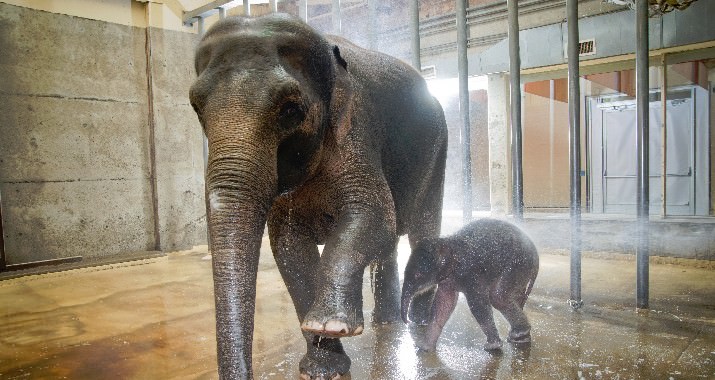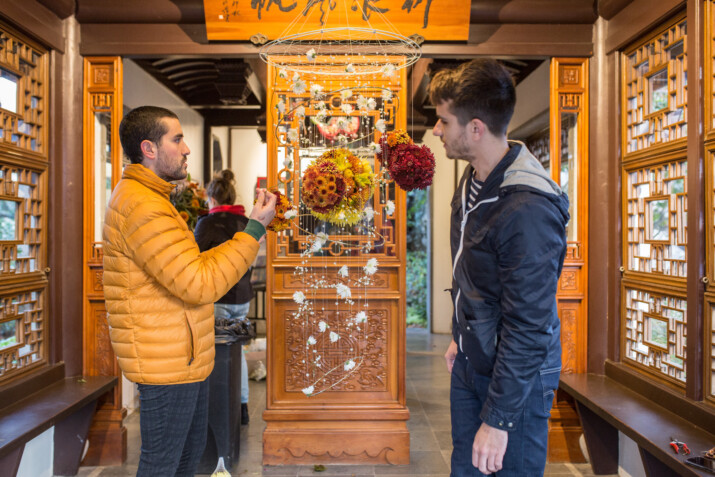Portland, January 3rd. Throughout the year, the biggest developing story at the zoo was the baby growing inside Rose-Tu. As the 18-year-old Asian elephant neared the end of her 22-month pregnancy, the zoo’s animal-care staff helped ensure a safe and healthy delivery by monitoring her weight, leading her through daily exercises, and creating a calming birth environment. On Nov. 30 at 2:17 a.m., Rose delivered a healthy, 300-pound female calf. Here’s a video of Lily now:
It’s been a big year for Oregon Zoo elephants, from the 50th birthday of Packy in April to the birth of the newest member of the herd, Lily, in November. As the zoo celebrates a half-century of working with elephants, it looks forward to breaking ground on a visionary expansion of the Asian elephant habitat next spring.
In a public vote on baby names selected by elephant keepers, more than 60 percent of the 50,000-plus voters chose the name Lily for the new calf — following the floral theme of her mom’s name (Rose-Tu, or Rose for short). But Lily is no wallflower — the youngster is proving a boisterous addition to the zoo’s Asian elephant herd, and is quickly bonding with her mother and the other elephants. Visitors can usually see her from 10 a.m. to 2 p.m. daily.
“I love seeing the way visitors respond to Lily’s energy and spirit,” said Bob Lee, the zoo’s elephant curator. “When people connect with Lily and see the bond between Rose-Tu and her calf, it brings home what we’re doing every day to make a good life for elephants.”
The Oregon Zoo is recognized worldwide for its successful Asian elephant breeding program, which has now spanned 50 years. Rose-Tu’s mother, Me-Tu, was the second elephant born at the zoo (just months after Packy in 1962), and her grandmother, Rosy, was the first elephant ever to live in Oregon.
Packy turns 50
On April 14, the zoo celebrated the 50th birthday of Packy, the iconic pachyderm who kicked off a half-century of successful elephant breeding at the Oregon Zoo. Packy put Portland on the map in 1962, making international news as the first elephant born in the Western Hemisphere in 44 years. He’s held a special spot in his fans’ hearts ever since. Packy’s birth also helped scientists better understand elephants — his mother’s pregnancy established the length of elephant gestation, for example — and opened the door to a new era in elephant welfare.
Packy is now the oldest and tallest male Asian elephant in North America. The zoo celebrated Oregon’s biggest celebrity with a birthday bash featuring music, games and an enormous cake. Packy was also knighted by the Royal Rosarians and honored by the Rose Festival as grand marshal for the year’s Grand Floral Parade.
“The Oregon Zoo is world-renowned for its Asian elephant program,” said Kim Smith, zoo director, “and Packy’s birth was the cornerstone on which this program was built. He has been inspiring people to care about elephants for half a century.”
Zoo lays groundwork for visionary new Elephant Lands habitat
The Oregon Zoo is poised to begin construction in 2013 on Elephant Lands, an expansion of the elephant habitat that will quadruple the elephants’ space and dramatically enhance their experiences and daily routines. The herd will have access to a variety of habitats and terrain, from rolling meadow to hilly forest. Designed for elephant comfort, health and enjoyment, Elephant Lands will include scratching surfaces, elephant controlled showers, pools for bathing and mud wallows to cool and protect skin.
Elephant Lands puts into practice the zoo’s philosophy that all animals should have choices over how they spend their days and nights and access to the outdoors. Forest Hall, a multistory covered enclosure with natural flooring, will provide elephants with shelter from summer heat and winter cold, with wide-open doors to the meadows and forests, pools and wallows.
In addition, zoo visitors can expect completely new options for viewing these mighty and majestic animals.
In December, Metro Council directed Metro’s COO to exercise the option the agency holds on the former site of Roslyn Lake in rural Clackamas County and purchase the 260-acre parcel from Portland General Electric for development as a future remote elephant center. This allows the zoo to purchase the property at an agreed-upon price that is set to expire at the end of this year. The zoo anticipates that development may be several years in the future. With the purchase, the zoo can move forward on specific site development plans. In the mean time, zoo officials are exploring long-term strategies for funding the center’s operations.
Samudra gets life lessons from dad
In June, the zoo honored Tusko as its Father of the Year. The sire of both Lily and her 4-year-old brother Samudra, Tusko has been giving Sam life lessons in what it means to be a bull. Keepers believe that seeing male behavior modeled from an early age will have a positive effect on Samudra’s ability to socialize with the herd as he matures.
In the past year, Tusko has been teaching Samudra how male elephants, called bulls, interact with female elephants. The 40-year-old bull has also taught the youngster to respect him as the dominant male of the family grouping by, among other things, waiting to eat until after Tusko has eaten and not facing the impressive bull directly.
Keepers hope that by learning to be a docile male elephant in his youth, Samudra will mature more slowly and therefore remain with his mother and aunties for a longer time before separating from the herd, as males do in the wild.
Research aims to safeguard elephant welfare
This year, the zoo continued its leading role in research to understand Asian elephants and safeguard their welfare, both in human care and in the wild. The zoo is collaborating with the National Zoo on research to protect elephant health by identifying the causes of EEHV, the deadliest viral disease affecting Asian elephants both in zoos and in the wild. The Oregon Zoo is also supporting research into treatments such as the promising antiviral drug glancovir.
The zoo’s Asian elephant Chendra is also helping researchers protect her endangered subspecies of elephants on the island of Borneo. They’re examining the DNA of Chendra and other Borneo elephants in Malaysia to understand the pachyderm’s genome and protect the genetic diversity of Borneo pygmy elephants, which number only about 2,000 in the wild and are highly threatened by habitat loss and fragmentation.
 Zoo works to protect elephants in the wild
Zoo works to protect elephants in the wild
As the Oregon Zoo worked to ensure the welfare of the elephants in its care, it also worked to protect elephants in the wild. Asian elephants are considered highly endangered in their range countries, threatened by habitat loss and conflict with humans. It is estimated that fewer than 40,000 elephants remain in fragmented populations from India to Borneo. Through the International Elephant Foundation and the Association of Zoos and Aquariums, the zoo supported a broad range of elephant conservation efforts to help wild elephants.
This year, the zoo continued to support work to address human-elephant coexistence issues, including the introduction of palmyra palm tree barriers in Sri Lanka as a sustainable, ecofriendly long-term tool for deterring crop-raiding elephants. Kids in Sri Lankan schools are also learning about safety around elephants and ways to coexist in harmony.
Oregon Zoo-supported projects also empower local communities to monitor and protect their neighboring elephants. In Myanmar, Chin villagers are trained to survey elephants and patrol for poachers. And in Sumatra, once-neglected captive elephants are participating in direct field based wildlife conservation.
story credit, Oregon Zoo.








 Zoo works to protect elephants in the wild
Zoo works to protect elephants in the wild












